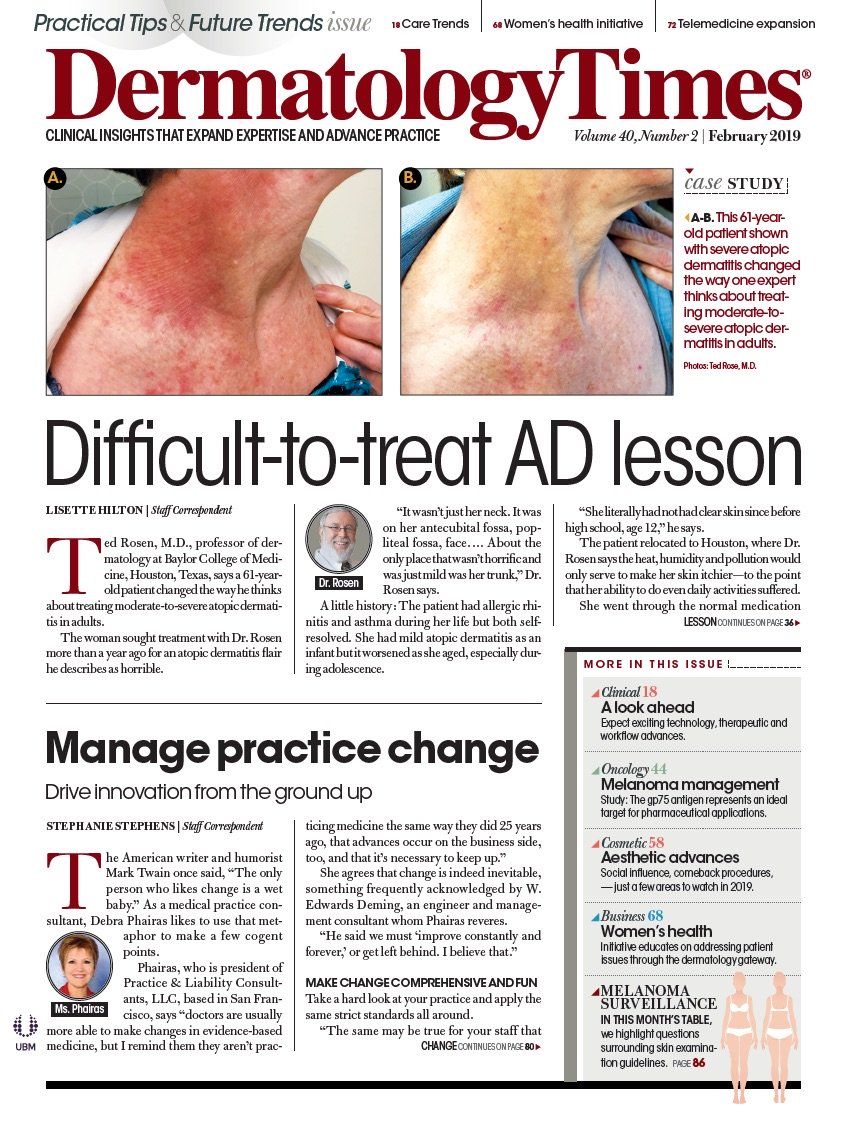- Case-Based Roundtable
- General Dermatology
- Eczema
- Chronic Hand Eczema
- Alopecia
- Aesthetics
- Vitiligo
- COVID-19
- Actinic Keratosis
- Precision Medicine and Biologics
- Rare Disease
- Wound Care
- Rosacea
- Psoriasis
- Psoriatic Arthritis
- Atopic Dermatitis
- Melasma
- NP and PA
- Skin Cancer
- Hidradenitis Suppurativa
- Drug Watch
- Pigmentary Disorders
- Acne
- Pediatric Dermatology
- Practice Management
- Prurigo Nodularis
- Buy-and-Bill
Publication
Article
Dermatology Times
Opportunities for collaboration with industry
Industry relationships are essential for innovation in dermatology. In this month's column, Steve Xu, M.D., and Michael L. Sierra, Ph.D., provide their insight on collaborating with industry.
Dr. Xu is a board-certified dermatologist and medical director of the Center for Bio-Integrated Electronics at the Simpson Querrey Institute for Bionanotechnology, Northwestern University. He is a co-founder of the Advancing Innovation in Dermatology Accelerator Fund.

Michael L. Sierra, Ph.D., vice president of LEO Science & Tech Hub, Cambridge, Mass. The Hub is a research and development innovation unit of LEO Pharma A/S. He is a steering committee member of the Advancing Innovation in Dermatology Accelerator Fund.

Innovation is an expensive, arduous and long process. Partnerships are key for success. In drug development, industry relationships are close to essential. For medical devices, industry partnerships can be extremely helpful in navigating the expensive regulatory process. Even within health information technology, there is a strong and growing interest from traditional industry players to get involved in the deployment of software solutions and to generate scale.
Academic and industry collaborations are essential to bring together the critical capabilities and resources necessary to move innovations to the marketplace. Many physicians have collaborative relationships with industry through consulting, sponsored research programs, joint development agreements and technology development. Collaborations with industry offer new opportunities and challenges for physicians seeking intellectually stimulating side ventures. While physicians know medicine and they know science, they may not know business, which is why these collaborations can be essential.
Over the past several years, there has been a trend in industry to create innovation hubs to foster collaborations between physicians, scientists, engineers and industry. The hubs create a natural conduit to foster discussion and lend support to novices seeking to launch a product, device, software solution-or, really, the sky is the limit.
Here are few examples of innovation hubs:
LEO Science & Tech Hub (LEO Pharma): The LEO Science & Tech Hub is a R&D innovation unit of LEO Pharma. They explore cutting-edge science and technology opportunities with relevance to dermatology. Their interests include non-invasive biomarkers, imaging technologies and artificial intelligence.
Johnson and Johnson Innovation, JLABS: This group invites collaborations across the entire spectrum of pharmaceuticals, medical devices and consumer health. They offer mentorship, grants and incubator space. Over the course of six years, companies incubated at JLABS have secured more than $11.6 billion in funding, 10 IPOs and 12 acquisitions. Dermatology remains a significant portfolio of J&J’s pharmaceutical subsidiary (Janssen) as well as its consumer health portfolio as makers of Neutrogena.
AlmirallShare: The Spanish pharmaceutical company Almirall has established an open platform to encourage outside innovators to work with Almirall to develop new, innovative solutions for skin health. Their initial focus centers on inflammatory skin conditions such as rosacea, and acne.
Bayer LifeScience iHUB, Bayer Open Innovation: Like Johnson & Johnson, Bayer AG is a massive organization with its own innovation program. Across their pharmaceuticals and consumer health divisions, there are opportunities for innovators to engage with Bayer on areas of shared interest.
L’Oréal’s Technology Incubator: L’Oréal’s supports a technology incubator to engage with outside partnerships. This work has led to new devices such as UV sensors and smart combs.
Innovations centers open new doors to innovators or wannabe innovators who may need guidance with research, product development, regulatory hurdles and marketing. Â
Here are some tips for collaboration with industry:
1. Manage expectations
These are large, complex organizations with an unknowable set of interests that change. You may have the greatest basal cell carcinoma drug candidate, but a company may simply be exiting skin oncology for strategic reasons. So, a “no” now may not be a “no” forever.
2. Have a realistic view of confidentiality
The value you offer is your idea, so sharing what you are working on is a prerequisite to collaboration. File patents (even inexpensive provisional patents) and request confidentiality agreements, but do not let the fear of someone stealing your idea prevent you from identifying a critical partner.
3. Clarity is key
You may have a platform technology, but identifying one or two key beachheads really help your potential industry partners understand what you want to do and whether they are a good fit.
Disclosures:Dr. Xu has received support from Leo Science and Tech Hub and L’Oreal for development projects.







